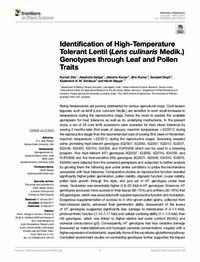Identification of High-Temperature Tolerant Lentil (Lens culinaris Medik.) Genotypes through Leaf and Pollen Traits

Authors:
Rising temperatures are proving detrimental for various agricultural crops. Cool-season legumes such as lentil (Lens culunaris Medik.) are sensitive to even small increases in temperature during the reproductive stage, hence the need to explore the available germplasm for heat tolerance as well as its underlying mechanisms. In the present study, a set of 38 core lentil accessions were screened for heat stress tolerance by sowing 2 months later (first week of January; max/min temperature >32/20°C during the reproductive stage) than the recommended date of sowing (first week of November; max/min temperature <32/20°C during the reproductive stage). Screening revealed some promising heat-tolerant genotypes (IG2507, IG3263, IG3297, IG3312, IG3327, IG3546, IG3330, IG3745, IG4258, and FLIP2009) which can be used in a breeding program. Five heat-tolerant (HT) genotypes (IG2507, IG3263, IG3745, IG4258, and FLIP2009) and five heat-sensitive (HS) genotypes (IG2821, IG2849, IG4242, IG3973, IG3964) were selected from the screened germplasm and subjected to further analysis by growing them the following year under similar conditions to probe the mechanisms associated with heat tolerance. Comparative studies on reproductive function revealed significantly higher pollen germination, pollen viability, stigmatic function, ovular viability, pollen tube growth through the style, and pod set in HT genotypes under heat stress. Nodulation was remarkably higher (1.8–22-fold) in HT genotypes. Moreover, HT genotypes produced more sucrose in their leaves (65–73%) and anthers (35–78%) that HS genotypes, which was associated with superior reproductive function and nodulation. Exogenous supplementation of sucrose to in vitro-grown pollen grains, collected from heat-stressed plants, enhanced their germination ability. Assessment of the leaves of HT genotypes suggested significantly less damage to membranes (1.3–1.4-fold), photosynthetic function (1.14–1.17-fold) and cellular oxidizing ability (1.1–1.5-fold) than HS genotypes, which was linked to higher relative leaf water content (RLWC) and stomatal conductance (gS). Consequently, HT genotypes had less oxidative damage (measured as malondialdehyde and hydrogen peroxide concentration), coupled with a higher expression of antioxidants, especially those of the ascorbate–glutathione pathway. Controlled environment studies on contrasting genotypes further supported the impact of heat stress and differentiated the response of HT and HS genotypes to varying temperatures. Our studies indicated that temperatures >35/25°C were highly detrimental for growth and yield in lentil. While HT genotypes tolerated temperatures up to 40/30°C by producing fewer pods, the HS genotypes failed to do so even at 38/28°C. The findings attributed heat tolerance to superior pollen function and higher expression of leaf antioxidants.
